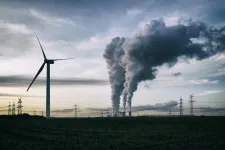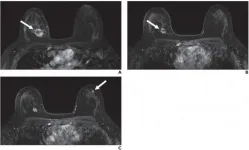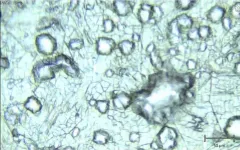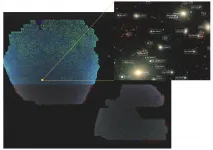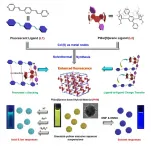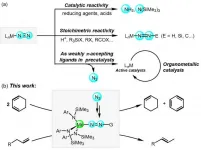(Press-News.org) There is a growing consensus among scientists as well as national and local governments representing hundreds of millions of people, that humanity faces a climate crisis that demands a crisis response. New research from the University of California San Diego explores one possible mode of response: a massively funded program to deploy direct air capture (DAC) systems that remove CO2 directly from the ambient air and sequester it safely underground.
The findings reveal such a program could reverse the rise in global temperature well before 2100, but only with immediate and sustained investments from governments and firms to scale up the new technology.
Despite the enormous undertaking explored in the study, the research also reveals the need for governments, at the same time, to adopt policies that would achieve deep cuts in CO2 emissions. The scale of the effort needed just to achieve the Paris Agreement goals of holding average global temperature rise below 2 degrees Celsius is massive.
The study, published in Nature Communications, assesses how crisis-level government funding on direct air capture--on par with government spending on wars or pandemics--would lead to deployment of a fleet of DAC plants that would collectively remove CO2 from the atmosphere.
"DAC is substantially more expensive than many conventional mitigation measures, but costs could fall as firms gain experience with the technology," said first-author Ryan Hanna, assistant research scientist at UC San Diego. "If that happens, politicians could turn to the technology in response to public pressure if conventional mitigation proves politically or economically difficult."
Co-author David G. Victor, professor of industrial innovation at UC San Diego's School of Global Policy and Strategy, added that atmospheric CO2 concentrations are such that meeting climate goals requires not just preventing new emissions through extensive decarbonization of the energy system, but also finding ways to remove historical emissions already in the atmosphere.
"Current pledges to cut global emissions put us on track for about 3 degrees C of warming," Victor said. "This reality calls for research and action around the politics of emergency response. In times of crisis, such as war or pandemics, many barriers to policy expenditure and implementation are eclipsed by the need to mobilize aggressively."
Emergency deployment of direct air capture
The study calculates the funding, net CO2 removal, and climate impacts of a large and sustained program to deploy direct air capture technology.
The authors find that if an emergency direct air capture program were to commence in 2025 and receive investment of 1.2-1.9% of global GDP annually it would remove 2.2-2.3 gigatons of CO2 by the year 2050 and 13-20 gigatons of CO2 by 2075. Cumulatively, the program would remove 570-840 gigatons of CO2 from 2025-2100, which falls within the range of CO2 removals that IPCC scenarios suggest will be needed to meet Paris targets.
Even with such a massive program, the globe would see temperature rise of 2.4-2.5ºC in the year 2100 without further cuts in global emissions below current trajectories.
Exploring the reality of a fleet of CO2 scrubbers in the sky
According to the authors, DAC has attributes that could prove attractive to policymakers if political pressures continue to mount to act on climate change, yet cutting emissions remains insurmountable.
"Policymakers might see value in the installation of a fleet of CO2 scrubbers: deployments would be highly controllable by the governments and firms that invest in them, their carbon removals are verifiable, and they do not threaten the economic competitiveness of existing industries," said Hanna.
From the Civil War to Operation Warp Speed, the authors estimate the financial resources that might be available for emergency deployment of direct air capture--in excess of one trillion dollars per year--based on previous spending the U.S. has made in times of crisis.
The authors then built a bottom-up deployment model that constructs, operates and retires successive vintages of DAC scrubbers, given available funds and the rates at which direct air capture technologies might improve with time. They link the technological and economic modeling to climate models that calculate the effects of these deployments on atmospheric CO2 concentration level and global mean surface temperature.
With massive financial resources committed to DAC, the study finds that the ability of the DAC industry to scale up is the main factor limiting CO2 removal from the atmosphere. The authors point to the ongoing pandemic as an analog: even though the FDA has authorized use of coronavirus vaccines, there is still a huge logistical challenge to scaling up production, transporting, and distributing the new therapies quickly and efficiently to vast segments of the public.
Conventional mitigation is still needed, even with wartime spending combating climate change
"Crisis deployment of direct air capture, even at the extreme of what is technically feasible, is not a substitute for conventional mitigation," the authors write.
Nevertheless, they note that the long-term vision for combating climate requires taking negative emissions seriously.
"For policymakers, one implication of this finding is the high value of near-term direct air capture deployments--even if societies today are not yet treating climate change as a crisis--because near term deployments enhance future scalability," they write. "Rather than avoiding direct air capture deployments because of high near-term costs, the right policy approach is the opposite."
Additionally, they note that such a large program would grow a new economic sector, producing a substantial number of new jobs.
The authors conclude it is time to extend research on direct air capture systems to real-world conditions and constraints that accompany deployment--especially in the context of acute political pressures that will arise as climate change becomes viewed as a crisis.
INFORMATION:
Leesburg, VA, January 14, 2021--According to ARRS' American Journal of Roentgenology (AJR), new suspicious findings occurred in 5.5% of breast MRI examinations performed to monitor response to neoadjuvant therapy; none of these new lesions were malignant.
"Our findings suggest that new lesions that arise in the setting of neoadjuvant therapy are highly unlikely to represent a new site of malignancy, particularly if the index malignancy shows treatment response," wrote Donna A. Eckstein and colleagues in the department of radiology and biomedical imaging at the University of California, San Francisco.
Based on a presentation at the ARRS 2019 Annual Meeting, Honolulu, ...
Scientists at the University of Tsukuba show that using a layer of graphene just one atom thick improves the catalytic activity of nickel or copper when generating hydrogen gas, which may lead to cheaper fuel for zero-emission automobiles
Tsukuba, Japan - A team of researchers led by the Institute of Applied Physics at the University of Tsukuba has demonstrated a method for producing acid-resistant catalysts by covering them with layers of graphene. They show that using few layers allows for greater proton penetration during a hydrogen evolution reaction, which is crucial for maximizing ...
The Beijing-Arizona Sky Survey (BASS) team of National Astronomical Observatories of Chinese Academy of Sciences (NAOC) and their collaborators of the Dark Energy Spectroscopic Instrument (DESI) project released a giant 2D map of the universe, which paves the way for the upcoming new-generation dark energy spectroscopic survey.
Modern astronomical observations reveal that the universe is expanding and appears to be accelerating. The power driving the expansion of the universe is called dark energy by astronomers. The dark energy is still a mystery and accounts for about 68% of the substance ...
Organic luminescent materials have been highlighted as an exciting research topic owing to their prominent potentials in light-emitting diodes, fluorescent sensors, optoelectronic devices, in vivo imaging, anti-counterfeiting, data storage, and information encryption. However, applications of tunable fluorescent materials in the solid states have been largely hampered because these luminescent systems generally require time-consuming organic synthesis procedures and suffer from reduced photoluminescence (PL) owing to the notorious aggregation caused quenching. Aggregation-induced ...
As an elementary type of collective excitation, plasmon has been found to dominate the optical properties of metals. The collective behavior of electrons in plasmons reflects the important difference between condensed matter and molecule-like ones. It is of great significance to study the evolution of plasmonic response and find out the boundary.
Controversy exists on such interesting questions as the division between the nanoparticle and molecules, and the physics of mesoscopic and microscopic plasmonic evolution. A unified understanding covering the small and large size limit, namely macro / meso / micro scales with sufficiently atomic precision is thus required. Clusters, as the transition from atomic molecules to condensed matter, are the ideal candidate for studying the evolution ...
Making people stand in front of a scanner to have their body temperature read can result in a large number of false negatives, allowing people with Covid-19 to pass through airports and hospitals undetected.
A new study argues that taking temperature readings of a person's fingertip and eye would give a significantly better and more reliable reading and help identify those with fever.
The study, co-led by human physiologist and an expert in temperature regulation, Professor Mike Tipton, is published in Experimental Physiology.
Professor Tipton, ...
Dinitrogen (N2) fixation is considered as one of the most essential tasks in basic science, providing straightforward methods to produce ammonia and nitrogen-containing molecules. Exploring the reactivity of N2 units of transition metal-nitrogen complexes is of great significance and challenging in the chemistry. Since the first Ru-N2 complex was prepared in 1965, important progress has been made in the synthesis and reactivity of transition metal nitrogen complexes. In many cases, terminal end-on M-N2 complexes as the most prevalent bonding mode were proved ...
In a new study, an international research team led by Sebastian Stumpf from the University of Vienna describes an exceptionally well-preserved skeleton of the ancient shark Asteracanthus. This extremely rare fossil find comes from the famous Solnhofen limestones in Bavaria, which was formed in a tropical-subtropical lagoon landscape during the Late Jurassic, about 150 million years ago. The almost complete skeleton shows that Asteracanthus was two-and-a-half meters long in life, which makes this ancient shark one of the largest of its time. The study is published in the journal Papers in Palaeontology.
Cartilaginous fishes, which include sharks and rays, are one of the most successful vertebrate groups still ...
Climate and changes in it have direct impacts on species of plant and animals - but climate may also shape more complex biological systems like food webs. Now a research group from the University of Helsinki has investigated how micro-climate shapes each level of the ecosystem, from species' abundances in predator communities to parasitism rates in key herbivores, and ultimately to damage suffered by plants. The results reveal how climate change may drastically reshape northern ecosystems.
Understanding the impact of climatic conditions on species interactions is imperative, as these interactions include such potent ecological forces as herbivory, pollination and parasitism.
Lead researcher Tuomas Kankaanpaa from the Faculty of Agriculture and Forestry, University of Helsinki, investigated ...
Astronomers using images from Kitt Peak National Observatory and Cerro Tololo Inter-American Observatory have created the largest ever map of the sky, comprising over a billion galaxies. The ninth and final data release from the ambitious DESI Legacy Imaging Surveys sets the stage for a ground-breaking 5-year survey with the Dark Energy Spectroscopic Instrument (DESI), which aims to provide new insights into the nature of dark energy. The map was released today at the January 2021 meeting of the American Astronomical Society.
For millennia humans have used maps to understand and navigate our world and put ourselves in context: we rely on maps to show us where we are, where we came from, and where we're going. Astronomical maps continue this tradition on a vast scale. They ...
